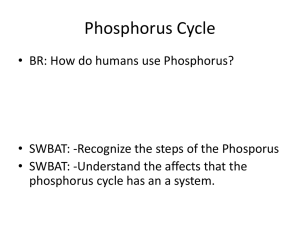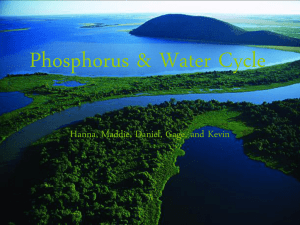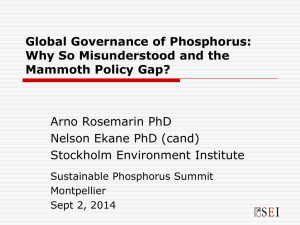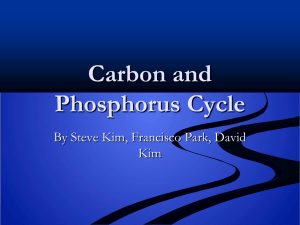EFFECTS OF WASTEWATER TREATMENT TECHNOLOGY ON
advertisement
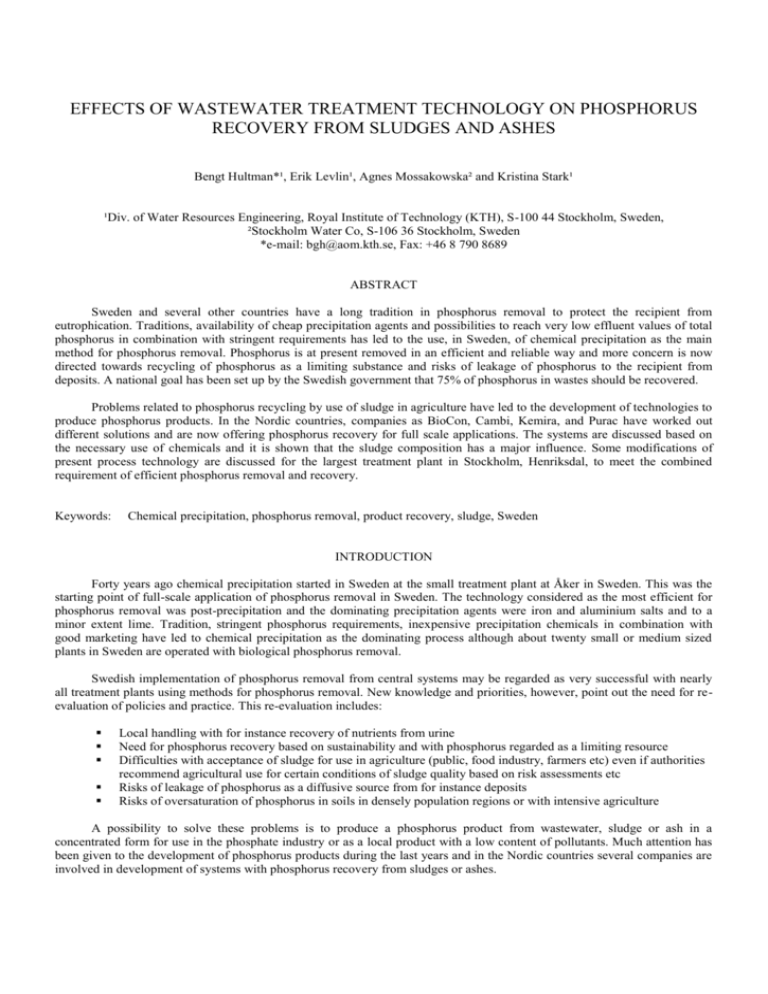
EFFECTS OF WASTEWATER TREATMENT TECHNOLOGY ON PHOSPHORUS RECOVERY FROM SLUDGES AND ASHES Bengt Hultman*¹, Erik Levlin¹, Agnes Mossakowska² and Kristina Stark¹ ¹Div. of Water Resources Engineering, Royal Institute of Technology (KTH), S-100 44 Stockholm, Sweden, ²Stockholm Water Co, S-106 36 Stockholm, Sweden *e-mail: bgh@aom.kth.se, Fax: +46 8 790 8689 ABSTRACT Sweden and several other countries have a long tradition in phosphorus removal to protect the recipient from eutrophication. Traditions, availability of cheap precipitation agents and possibilities to reach very low effluent values of total phosphorus in combination with stringent requirements has led to the use, in Sweden, of chemical precipitation as the main method for phosphorus removal. Phosphorus is at present removed in an efficient and reliable way and more concern is now directed towards recycling of phosphorus as a limiting substance and risks of leakage of phosphorus to the recipient from deposits. A national goal has been set up by the Swedish government that 75% of phosphorus in wastes should be recovered. Problems related to phosphorus recycling by use of sludge in agriculture have led to the development of technologies to produce phosphorus products. In the Nordic countries, companies as BioCon, Cambi, Kemira, and Purac have worked out different solutions and are now offering phosphorus recovery for full scale applications. The systems are discussed based on the necessary use of chemicals and it is shown that the sludge composition has a major influence. Some modifications of present process technology are discussed for the largest treatment plant in Stockholm, Henriksdal, to meet the combined requirement of efficient phosphorus removal and recovery. Keywords: Chemical precipitation, phosphorus removal, product recovery, sludge, Sweden INTRODUCTION Forty years ago chemical precipitation started in Sweden at the small treatment plant at Åker in Sweden. This was the starting point of full-scale application of phosphorus removal in Sweden. The technology considered as the most efficient for phosphorus removal was post-precipitation and the dominating precipitation agents were iron and aluminium salts and to a minor extent lime. Tradition, stringent phosphorus requirements, inexpensive precipitation chemicals in combination with good marketing have led to chemical precipitation as the dominating process although about twenty small or medium sized plants in Sweden are operated with biological phosphorus removal. Swedish implementation of phosphorus removal from central systems may be regarded as very successful with nearly all treatment plants using methods for phosphorus removal. New knowledge and priorities, however, point out the need for reevaluation of policies and practice. This re-evaluation includes: Local handling with for instance recovery of nutrients from urine Need for phosphorus recovery based on sustainability and with phosphorus regarded as a limiting resource Difficulties with acceptance of sludge for use in agriculture (public, food industry, farmers etc) even if authorities recommend agricultural use for certain conditions of sludge quality based on risk assessments etc Risks of leakage of phosphorus as a diffusive source from for instance deposits Risks of oversaturation of phosphorus in soils in densely population regions or with intensive agriculture A possibility to solve these problems is to produce a phosphorus product from wastewater, sludge or ash in a concentrated form for use in the phosphate industry or as a local product with a low content of pollutants. Much attention has been given to the development of phosphorus products during the last years and in the Nordic countries several companies are involved in development of systems with phosphorus recovery from sludges or ashes. The general scheme for phosphorus recovery from sludges and ashes normally involves the following processes: Transfer of dissolved, colloidal and suspended phosphorus into a solid phase (sludge) by use of biological and chemical methods in wastewater treatment Transfer of phosphorus in the sludge into a solution by use of biological, chemical or thermal methods Transfer of soluble phosphorus into a product by use of chemical precipitation or ion exchange PRODUCTION OF PHOSPHORUS COMPOUNDS IN THE PHOSPHATE INDUSTRY Production of commercial phosphorus products in the phosphate industry has as the first step production of phosphoric acid by use of thermal methods or chemical extraction. Main raw material is calcium phosphates as apatite. Henning Brandt, an alchemist from Hamburg, discovered phosphorus in 1669 by use of thermal treatment of urine in search for gold. Later on thermal treatment of bones from animals was used for phosphorus production. The thermal methods use mainly calcium phosphates as raw material together with coke as a carbon source and silica. The reaction takes place at about 1450 °C and silica reacts thereby with calcium to form a calcium silica slag and carbon reacts with the oxygen in phosphate to form elemental phosphorus and carbon monoxide: 2 Ca3(PO4)2 + 6 SiO2 + 10 C 6 CaSiO3 + 10 CO + P4 (i) From the produced phosphorus, phosphoric acid may be produced with a very high quality. The thermal route for phosphorus and phosphoric acid has recently been considered with wastewater sludge or ash as raw material [1]. In one experiment a phosphorus yield of 70% was obtained when ash with 15.8 % P2O5, 4.02 % CaO, 2.13 % Fe2O3, 21.4 % Al2O3 and 45.8 % SiO2 was heated at 1150 °C. The raw materials for production of phosphorus from sludges can be present, i.e. calcium phosphates, carbon and silica. Iron present in the sludge reduces the yield due to formation of ferrophosphorus. High energy consumption and relatively few uses of elemental phosphorus have diminished the use of the thermal method. However, if phosphorus recovery is required it seems important to evaluate its use for sludges and ashes. It is also possible to produce phosphorus from aluminium phosphate by heating with coke and lime at 1600 °C, although this method is not used in the phosphate industry. 4 AlPO4 + 2 CaO + 2 C 2 CaO.Al2O3 + 2 CO + P4 (ii) Phosphoric acid is mainly produced by a wet route. The most common raw material is calcium phosphates which are treated by an acid, normally sulphuric acid: Ca3(PO4)2 (s) + 3 H2SO4 + 6 H2O 2 H3PO4 + 3 CaSO4.2H2O (s) (iii) Calcium sulphate is separated from the phosphoric acid solution and the impure phosphoric acid, "green acid", is treated to remove impurities and concentrated. The similar technology as the wet route for phosphoric acid production in the phosphate industry is used by the Danish company BioCon. In this process, which will be described later, ashes are treated with sulphuric acids, impurities are removed by ion exchange and phosphoric acid is concentrated by use of ion exchange. INORGANIC COMPOSITION OF ASHES FROM SLUDGES The inorganic composition of different ashes from incineration of wastewater sludges varies a lot depending on the process technology in wastewater treatment. Examples are shown in Table 1 of ashes from different sludges. Table 1. Content in per cent for nine ashes from sludge incineration [2, 3, 4], one dried sludge J [5] and mean values. Also included are the mole quotas for Fe/P and Al/Si and content in sludge from Henriksdal [6] and digested sludge treated by heat and acids (KREPRO) [7]. Sludge A [2] B [2] C [2] D [2] E [3] F [4] G [4] H [4] I [4] J [5] Mean Henriksdal KREPRO Al2O3 % 15.6 14.8 15.3 11.1 12.9 14.2 12.3 16.2 16.9 23.58 15.3 7.2 15.2 CaO % 12.3 7.9 10.9 7.6 17.1 10.0 13.2 20.8 16.9 6.38 12.3 5.3 1.3 Fe2O3 % 5.4 11.9 5.5 24.6 11.2 17.9 15.1 2.8 5.6 12.1 11.2 30.0 3.8 K2 O % 0.5 1.7 1.9 0.8 2.1 1.2 1.4 1.4 1.6 1.43 1.4 0.92 2.8 MgO % 2.5 2.8 3.8 3.3 2.6 1.5 1.5 1.4 1.6 2.15 2.3 1.7 1.6 Na2O % 0.3 0.6 0.4 0.7 1.1 0.7 0.6 0.6 0.7 1.55 0.73 0.54 3.2 P2O5 % 14.0 20.7 26.7 22.1 15.8 (1.5) 13.2 18.4 13.8 14.4 17.7 19.0 5.4 SiO2 % 41.6 34.6 31.8 25.7 30.4 36.2 36.5 30.3 35.2 37.1 33.9 19.0 61.4 mole Fe mole P 0.34 0.51 0.18 0.99 0.63 1.02 0.14 0.36 0.75 0.55 1.40 0.63 mole Al mole Si 0.44 0.50 0.57 0.51 0.50 0.46 0.40 0.63 0.57 0.75 0.53 0.45 0.29 The sludges A-J are from Japanese or German wastewater treatment plants and show that main components in sludges are Al2O3 (11 - 24%) and SiO2 (30-41%). The treatment plant at Henriksdal has precipitation with ferrous iron, which is shown by the high molar ratio of Fe/P and the relatively low percentage amount of Al 2O3 and SiO2 (due to the high percentage amount of Fe2O3). The quotient mole Al/mole Si is, however, similar to sludges A-J. The sludge "KREPRO" indicates that SiO2 is not or only to a minor extent dissolved by heat and sulphuric acid. The relatively low ratio of mole Al/mole Si indicates that part of the aluminium is dissolved although a significant fraction remains unsolved. SYSTEMS FOR RECOVERY OF PHOSPHORUS The methods of phosphorus recovery may be divided into the following groups: Recovery in the wastewater treatment Recovery from the produced sludge Phosphates may be removed in the main stream after biological treatment as calcium phosphate (use of for instance Crystallactor), use of ion exchange technology (as REM-NUT) for the production of magnesium ammonium phosphate or use of adsorption of phosphate on activated alumina, which is regenerated by sodium hydroxide. From the regeneration solution calcium phosphates may be produced by addition of calcium chloride. It is also possible to produce phosphorus products (calcium phosphates or magnesium ammonium phosphate) by treatment of a fraction of the return sludge from an activated sludge plant with enhanced biological phosphorus removal. Anaerobic treatment of the return sludge fraction gives rise to release of phosphorus, which can be recovered in a separate step. Calcium phosphate produced in a separate step can be a raw material for the production of phosphoric acid. Magnesium ammonium phosphate may be used directly as a fertiliser if the ratio of toxic metals to the phosphorus content in the fertiliser is low. The sludge produced from a wastewater treatment plant may be used directly as a resource in agriculture if the amount of pollutants is low in the sludge. However, in Sweden and many other countries, sludge use in agriculture has diminished due to resistance from the food industry and lack of social acceptance, even if the sludge quality is very high. In this case, phosphorus recovery from sludges is a possibility. A national goal has recently been proposed in a report to the Swedish government that at least 75% of phosphorus from wastewater should be recovered at latest 2010 without risks for health and the environment. Sludge incineration should therefore include technology to either recover phosphorus before incineration or from the produced ashes. Phosphorus in sludges is bounded both biologically and chemically. If enhanced biological phosphorus removal is used a significant release of phosphates is obtained during anaerobic treatment in digesters. In dewatering of the digested sludge a supernatant is obtained rich in both phosphates and ammonium. Special treatment of the supernatant with lime to precipitate phosphates followed by ammonia stripping or precipitation with magnesium ions and sodium hydroxide are examples of recovery both of phosphates and ammonium. A large part of phosphorus in ashes is released easily in a relatively short time in incineration of sludges from enhanced biological removal [8]. However, the goal from the Swedish government of 75% phosphorus recovery would probably not be met by use of enhanced biological phosphorus removal followed by phosphate release and recovery. Different ions as magnesium and calcium and zeolites from detergents may cause refixation of dissolved phosphate in the digester supernatant [9]. More efficient leaching methods are therefore needed for a high phosphorus recovery. The use of sulphuric acid for leaching of phosphorus from sludges or ashes followed by phosphorus recovery have been proposed by BioCon in Denmark and a group of companies (Cambi, Kemira and Purac) in Scandinavia. NORDIC SYSTEMS FOR PHOSPHORUS RECOVERY Two systems (Cambi/KREPRO and BioCon) are at present offered for full-scale applications. The system Cambi/KREPRO has recently been proposed and combines process units from earlier sludge handling systems. The system by Cambi has as main goals to decrease the sludge production and increase the biogas production. This was accomplished by use of steam as a heat source directly into pre-dewatered sludge before the digester. The heat treatment dissolved organic materials from the sludge and increased the biodegradability. The first plant was commissioned 1996 in full scale in Hamar in Norway. Later on plants have been commissioned in Næstvæd south of Copenhagen, in Chertsey (west of London) and an additional plant is planned for Aberdeen [10]. The KREPRO (Kemwater REcycling PROcess) system uses heat, pressure and sulphuric acid to dissolve phosphates, metals and a large fraction of organic compounds from the sludge. Remaining sludge has a concentration of about 45-50% DS and the energy value of the sludge is comparable to wood chips and is suitable for combustion. Phosphorus is recovered as ferric phosphate and ferrous iron as a precipitation agent. The dissolved organic material can be used as a carbon source in denitrification. A full-scale recovery plant with the KREPRO system has been in operation at Helsingborg wastewater treatment plant in Sweden and with a maximum capacity of 500 kg DS h -1 [11]. The system is shown in Figure 1. Digested sludge 5% DS Acid Reactor Mixture tank Flush tank Steam Heat exchanger Centrifuge inorganic sludge FePO4 35% DS Figure 1. Fe Alkali FePO4 precipitation Centrifuge organic sludge Organic sludge 45% DS The KREPRO system [11]. The combined Cambi/KREPRO system is shown in Figure 2. Dewatered sludge is hydrolysed at a temperature of about 150 °C and a pH-value between 1 and 2. Remaining sludge consists mainly of organic material and may be incinerated. The major part of the heavy metals follows the organic sludge and a minor part is removed in a separate step with sulphide precipitation. The dissolved iron is in ferrous form. It is later on oxidised to ferric hydroxide and recycled to precipitate ferric phosphate. Part of the ferric hydroxide is recovered as a coagulant. Dissolved organic material can be used as a carbon source in denitrification of supernatant. External sludge Acid Steam Dilution pH-adjustment Digested sludge Dewatering Mixing DS 20 % Hydrolysis Temp 150°C pH 1-2 Fibre fraction DS 45 % Dewatering pH-adjustment pH-adjustment Treatment of supernatant Separation of iron hydroxide Separation of heavy metals Phosphorus precipitation Iron phosphate Phosphorus recovery 75 % Recovery of iron salts Figure 2. Process scheme for Cambi/Krepro [7]. The BioCon system consists of three main parts, a heat drying unit for dewatered sludge, an incineration step for the heat dried sludge and a recovery step for the obtained ash. The recovery step is shown in Figure 3. The ash is after grinding treated with sulphuric acid. Phosphates and most of the metals (except calcium and lead that form insoluble sulphates) are dissolved. By use of ion exchange ferric iron, phosphoric acid and potassium hydrogen sulphate are recovered and heavy metals are transferred to a small waste stream. Incineration Drying Sludge Ash silo Natural gas Ash breaker Ion exchange battery H2SO4 Water Dissolving device Water to treatment plant Sand FeCl3 Figure 3. KHSO4 H3PO4 Sludge residue Process scheme for BioCon [12]. NEEDS OF CHEMICALS FOR PHOSPHORUS RECOVERY Dissolution of phosphorus and metals The systems in Fig. 1-3 for phosphorus and metals recovery use dissolution of the sludge by addition of sulphuric acid. The recovery of products is then based on precipitation or ion exchange. The main inorganic metals in the sludge are iron, aluminium, calcium and magnesium and these metals must be considered in dissolution of sludge and ashes. Important dissolution reactions with acids are shown in Table 2. It is assumed that the pH-value is low (below 2) so that phosphoric acid is formed. Table 2. Main reactions in dissolution of metals in sludges or ashes by acids. Process Ferrous phosphate with hydrogen ions Calcium or magnesium carbonate (MeCO3) by hydrogen ions Ferric or aluminium phosphate (MePO4) by hydrogen ions Ferric or aluminium hydroxide (Me(OH) 3) by hydrogen ions Reactions Alkalinity change, ekv mole-1 + 2+ Fe3(PO4)2 + 6 H 3 Fe + 2 H3PO4 +3 per mole P +2 per mole Fe +2 per mole Me MeCO3 + 2 H+ Me 2+ + 2 HCO3– MePO4 + 3 H+ Me 3+ + H3PO4 +3 per mole P +3 per mole Fe Me(OH)3 + 3 H+ Me 3+ + 3 H 2O +3 per mole Me The dissolved metals and phosphates are later on recovered by precipitation or ion exchange in the KREPRO, Cambi/KREPRO and BioCon systems. The dissolved compounds are stoichiometrically precipitated or regenerated. This would indicate that about the same amounts of chemicals are needed (calculated as equivalents) for the dissolution phase and the recovery phase. The charges of dissolved compounds (as ferrous or ferric ions) and of the products also have an important influence. The need of acids to dissolve ferrous iron (as in digested sludge) is 2 ekv per mole Fe compared with ferric iron (as in incinerated sludges) with 3 ekv per mole Fe. An example of used resources and produced resources in metal and phosphorus recovery is given for the KREPRO process with data from Helsingborg wastewater treatment plant [11]. Table 3. Used and produced inorganic resources with KREPRO for sludge from Helsingborg [11]. Used resources Sulphuric acid: Sodium hydroxide: Magnesium hydroxide: Ferric chloride: 200 kg per tonne DS 200 kg per tonne DS 12 kg per tonne DS 390 kg per tonne DS Produced resources Phosphorus: Ferric phosphate (and ferric hydroxide): Ferrous iron (recovered): 27 kg per tonne DS 515 kg per tonne DS 38 kg per tonne DS The equivalents of added sulphuric acid is 4080 ekv per tonne DS and the equivalents of added alkalinity 5210 ekv per tonne DS. The somewhat higher amount of equivalents added of alkalinity compared with acids may be due to that ferrous iron was dissolved while ferric iron was precipitated. Applications for Henriksdal treatment plant Henriksdal is the largest treatment plant in Stockholm with 640,000 p.e. connected. The plant is operated with preprecipitation with ferrous sulphate, an activated sludge process with pre-denitrification and a polishing deep-bed filter to which is added small amounts of ferrous sulphate to improve the phosphorus removal efficiency. The composition of ash from the sludge is shown in Table 1. The major metals that are dissolved by addition of acids are Al, Fe, Ca and Mg. The sludge had a volatile fraction of 61.1%. The metal concentrations are 0.55 mole Al per kg DS, 1.46 mole Fe per kg DS, 0.37 mole per Ca kg DS, and 0.16 mole Mg per kg DS, respectively. The necessary amount of sulphuric acid for dissolution of these metals is, respectively: 81 kg per tonne DS (100% dissolution of Al); 40 kg per tonne DS (50% dissolution of Al) 215 kg per tonne DS (100% dissolution of ferric iron); 143 kg per tonne DS (100% dissolution of ferrous iron) 52 kg per tonne DS (100% dissolution of Ca and Mg) With a dissolution of 50% of Al and all Ca and Mg the need for sulphuric acids is 1885 ekv per tonne DS or 92 kg sulphuric acid per tonne DS. The need for acids with 100% dissolution of iron is 215 kg sulphuric acid per tonne DS (ferric iron) and 143 kg sulphuric acid per tonne DS (ferrous iron), respectively. DISCUSSION Systems with solution of phosphates and metals by acids followed by product recovery have to dissolve iron, calcium, magnesium and part of the aluminium. The calculated demand for acids is 92 kg H 2SO4 per tonne DS for digested sludge from the wastewater treatment plant at Henriksdal. The value varies with the wastewater composition (iron contents, hardness, etc.) and is approximately the value that could be reached if no chemicals were added for chemical precipitation. The use of iron as a precipitation agent with a dosage of 1.4 mole Fe per mole P (see Table 1) increases the necessary dosage of sulphuric acid with 143 kg per tonne DS for dissolution of the ferrous iron. The total needed amount of sulphuric acid is 235 kg per tonne DS. In Helsingborg about half of the plant is operated by simultaneous precipitation with ferrous sulphate and half by biological phosphorus removal. The dosage of iron calculated on the whole flow is about 0.7 mole Fe per mole of P. With this dosage the calculated need of sulphuric acid for Henriksdal is 164 kg per tonne DS. This value is somewhat lower than the obtained value for Helsingborg (200 kg per tonne DS) and may for instance depend on partial chemical precipitation of phosphorus in the biological phosphorus removal step and differences in wastewater composition. Although systems like KREPRO, Cambi/KREPRO and BioCon can recover phosphorus and iron salts, they benefit much if the added amount of precipitation agents is low due to operational costs for sulphuric acid and corresponding chemicals for product recovery. The need for both efficient phosphorus removal and recovery can make it advantageous to reconsider earlier proposed methods for recovery of phosphorus and metals as: Use of hydrogen sulphide to dissolve phosphates from ferric phosphate followed by recovery of calcium phosphates and ferric chloride (see Fig. 4) [13]. Hydrogen sulphide may also be produced biologically by reduction of sulphate and ferrous sulphate may be produced biologically by oxidation of ferrous sulphide. In process systems with hydrogen sulphide it is important to consider risks due to labour safety, corrosion and odour. H2S to adsorber Ca(OH)2 CaO Centrifuge FePO4 sludge Effluent H2S HCl H2S FeS (s) and other sulphides Ca3(PO4)2 (s) FeCl3 To FePO4 precipitation Other sulphides Figure 4. Dissolution and re-precipitation process for sludge treatment [13]. Use of aluminium salts as precipitation agent instead of iron salts. Aluminium hydroxide and aluminium phosphate may be dissolved by use of sodium hydroxide. The dissolved phosphate can be precipitated as calcium phosphates and obtained aluminate can be used as a coagulant. The efficiency of the aluminate may, however, be low [14]. If the efficiency of the aluminate solution for precipitation is not high enough, the alkalinity of the solution may be used for neutralisation of nitrification reactions in treatment of supernatant. The sludge composition from treatment plants from which phosphorus has been removed and recovered is suitable for the cement industry [15]. Use of combined effects of addition of acids or alkali in treatment of sludges to take benefits of alkalinity increase or decrease, dissolution of components from the sludge and reduction of the sludge amount. Combination of acid or alkali additions with mechanical disintegration of sludge is another interesting possibility. In order to reduce the need of mineral acids in the dissolution of phosphate and metals it may be possible to use nitrification bacteria, which produce hydrogen ions, organic acids formed during fermentation or carbonic acid for instance obtained in dissolving carbon dioxide from digester gas in water. A carbonic solution is also able to solubilize some of the organic material contained in the sludge. These have a clear aliphatic nature and contain a great quantity of nitrogen [16]. The systems proposed for phosphorus recovery may have disadvantages as low degree of phosphorus recovery (as systems with biological phosphorus removal, release of phosphate in the digester followed by phosphorus recovery) or high demands of chemicals especially if chemical precipitation is used. Different combinations of release of phosphorus from sludges both by biological and chemical methods followed by recovery may be advantageous to reach high degrees of recovery without too high additions of chemicals. An example is shown in Fig. 5. Sludge thickener Excess sludge Possible addition of post-precipitated sludge Anaerobic zone Figure 5. Phosphorus precipitation Phosphorus recovery Drying Incineration Addition of chemicals or heat for phosphorus release Anoxic zone Phosphorus recovery Aerobic zone A Phosphorus recovery B Recycling of precipitation agents or organic acids C Settler Phosphate release from sludges with biologically and chemically bound phosphorus followed by phosphorus recovery. The process way A has been proposed by Klapwijk et al. [17] with activated sludge taken from the anaerobic zone in a plant with biological phosphorus and nitrogen removal. A phosphate rich stream is obtained from a thickener of the digested sludge. By use of precipitation or crystallisation technique a phosphate product can be obtained. Part of the phosphorus is still bound in the excess sludge from the thickener. By use of process scheme B the excess sludge eventually with post-precipitated sludge may be treated to recover additional phosphorus and precipitation agents as in the BioCon system (figure 3) or the thermal way to recover lime and phosphorus in lime precipitation. Chemically bound phosphorus may also be recovered by process way C by adding chemicals and eventually heat for phosphate release from excess sludge and post-precipitated sludge followed by phosphorus recovery, for instance systems similar to KREPRO and Cambi/KREPRO (figure 1 and 2). In such systems precipitation agents may be recovered and an organic stream is produced containing easily biodegradable material as organic acids. The organic material may be recycled to the anaerobic zone in the activated sludge process in order to improve biological phosphorus removal. In process way C the excess sludge production is significantly reduced. CONCLUSIONS Requirements of both efficient phosphorus removal and recovery have led to reconsideration of present wastewater and sludge treatment in Sweden. Systems developed in the Nordic countries (KREPRO, Cambi/KREPRO and BioCon) have the possibilities to recover phosphorus and coagulants from plants with iron precipitation. As the need for chemical increases linearly with the iron dosage it is advantageous to use as little iron dosage as possible without reducing the phosphorus removal efficiency. Substitution of at least part of chemical precipitation agents with enhanced biological phosphorus removal is thereby beneficial. Systems with the use of hydrogen sulphide or aluminium salts as the precipitation agent also have the possibilities of phosphorus and coagulant recovery but have not come into practice. In order to save the necessary dosage of mineral acids the use of nitrification bacteria, produced organic acids or carbon dioxide are interesting possibilities. It may also be possible to combine methods of phosphorus recovery from streams with release of phosphates by use of anaerobic conditions and addition of chemicals, respectively. ACKNOWLEDGEMENT This study has been supported by MISTRA, Stockholm Water Co and CEEP as a part of a research program with the aim to find solutions for phosphorus recovery. REFERENCES 1. 2. 3. 4. 5. 6. 7. 8. 9. 10. 11. 12. 13. 14. 15. 16. 17. Nakahara, K., Hoshino, Y., Matsui, S., Shinagawa, T., Method for recovering phosphorus from organic sludge. US Patent 6,022,514; February 8, 2000 (2000). Ozaki, M., Watanabe, H. and Weibusch, B., Characteristics of heavy metal release from incinerated ash, melted slag and their re-products. Wat. Sci. Tech., 36, 11, 267-274 (1997). Takaoka, M., Takeda, N. and Miura, S., The behaviour of heavy metals and phosphorus in an ash melting process. Wat, Sci. Tech., 36, 11, 275-282 (1997). Wiebusch, B., Seyfried, C.F., Johnke, B., and Credo, S., Stand der Mono-Klärschlamm-Verbrennung in Deutschland. Korrespondenz Abwasser, 44, 3, 473-492 (1997). Abu-Kaddourah, Z., Idris, A., Noor, M.J.M.M. and Ahmadun, F.R., Effects of high temperature melting on the porosity and microstructure of slags from domestic sewage sludge. Wat. Sci. Tech., 41, 8, 99-105 (2000). Haglund, J.-E., Hultgren, J., Karlsson, B. and Årström, J., Förstudie angående slamförbränning vid Stockholm Vatten, Stockholm Vatten. R. Nr 10 (1997). Karlsson, I., The sludge disposal dilemma in Sweden. Kemira (2000). Matsuo, Y., Release of phosphorus from ash produced by incineration waste from activated sludge from enhanced biological phosphorus removal. Wat. Sci. Tech., 34, 1-2, 407-415 (1996). Wild, D., Kisliakova, A. and Siegrist, H., P-fixation by Mg, Ca and zeolite A during stabilisation of excess sludge from enhanced biological P-removal. Wat. Sci. Tech., 34. 1-2, 391-398 (1996). Weisz, N., Kepp, U., Norli, M., Panter, K. and Solheim, O.E., Sludge disintegration with thermal hydrolysis – case from Norway, Denmark, and United Kingdom. In: 1st World Water congress of IWA, Paris 3-7 July 2000, Conference Preprint Book 4, pp. 288-295 (2000). Hansen, B., Karlsson, I., Cassidy, S. and Pettersson, L., Operational experiences from a sludge recovery plant. Wat. Sci. Tech., 41, 8, 23-30 (2000). Svensson, A., Fosfor ur avloppsslam – en studie av KREPRO-processen och BioCons process ur ett livscykelperspektiv. Master Thesis. Kemisk miljövetenskap, Chalmers Tekniska Högskola (2000). Ripl, W., Stammert, B., Wiesmann, U. and Karimnia, M., Rückgewinnung von Phosphor und Fällungsmitteln (Eisen) aus Nachfällschlam. Vom Wasser, 70, 179-185 (1995). Culp, R.L. and Culp, G.L., Advanced wastewater treatment. Van Nostrand Reinhold Co., (1971). Onaka, T., Sewage can make Portland cement: A new technology for ultimate reuse of sewage sludge. Wat. Sci. Tech., 41, 8, 93-98 (2000). Petronio, B.M., Fortunati, A., Gennaro, M.C., Vanni, A., Petruzzelli, G. and Liberatori, A., Study of the organic matter and leaching process from municipal treatment sludge. J. Environ. Sci. Health., A28, 2, 299-319 (1993). Klapwijk, B., Rulkens, W. and Temmink, H., Recovery of phosphorus from sewage. Second International Conference on Recovery of Phosphates from Sewage and Animal Wastes, CEEP, Holland 12-13 March (2001).

